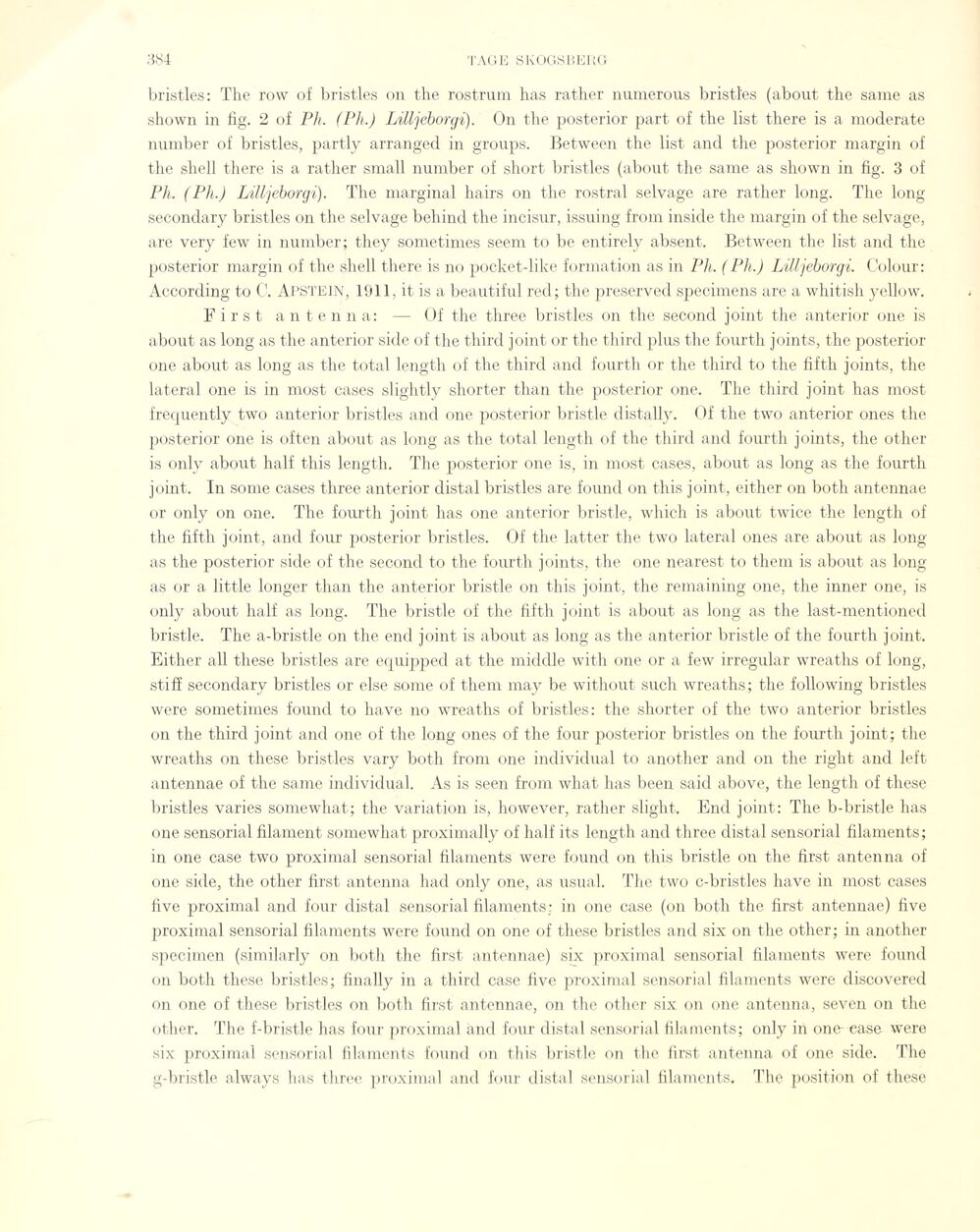
Full resolution (JPEG) - On this page / på denna sida - Sidor ...

<< prev. page << föreg. sida << >> nästa sida >> next page >>
Below is the raw OCR text
from the above scanned image.
Do you see an error? Proofread the page now!
Här nedan syns maskintolkade texten från faksimilbilden ovan.
Ser du något fel? Korrekturläs sidan nu!
This page has never been proofread. / Denna sida har aldrig korrekturlästs.
bristles: The row of bristles on the rostrum has rather numerous bristles (about the same as
shown in fig. 2 of Pli. (Pli.) Lilljebonji). On the posterior part of the list there is a moderate
number of bristles, partly arranged in groups. Between the list and the posterior margin of
the shell there is a rather small number of short bristles (about the same as shown in fig. 3 of
Ph. (Pli.) Lilljebonji). The marginal hairs on the rostral selvage are rather long. The long
secondary bristles on the selvage behind the incisur, issuing from inside the margin of the selvage,
are very few in number; they sometimes seem to be entirely absent. Between the list and the
posterior margin of the shell there is no pocket-like formation as in Pli. (Ph.) Lilljeborgi. Colour:
According to C. APSTEIN, 1911, it is a beautiful red; the preserved specimens are a whitish yellow.
First antenna: — Of the three bristles on the second joint the anterior one is
about as long as the anterior side of the third joint or the third plus the fourth joints, the posterior
one about as long as the total length of the third and fourth or the third to the fifth joints, the
lateral one is in most cases slightly shorter than the posterior one. The third joint has most
frequently two anterior bristles and one posterior bristle distally. Of the two anterior ones the
posterior one is often about as long as the total length of the third and fourth joints, the other
is only about half this length. The posterior one is, in most cases, about as long as the fourth
joint. In so me cases three anterior distal bristles are found on this joint, either on both antennae
or only on one. The fourth joint has one anterior bristle, which is about twice the length of
the fifth joint, and four posterior bristles. Of the latter the two lateral ones are about as
longas the posterior side of the second to the fourth joints, the one nearest to them is about as long
as or a little longer than the anterior bristle on this joint, the remaining one, the inner one, is
only about half as long. The bristle of the fifth joint is about as long as the last-ment ioned
bristle. The a-bristle on the end joint is about as long as the anterior bristle of the fourth joint.
Either all these bristles are equipped at the middle with one or a few irregulär wreaths of long,
stiff secondary bristles or else some of them may be without such wreaths; the following bristles
were sometimes found to have no wreaths of bristles: the shorter of the two anterior bristles
on the third joint and one of the long ones of the four posterior bristles on the fourth joint; the
wreaths on these bristles vary both from one individual to another and on the right and left
antennae of the same individual. As is seen from what has been said above, the length of these
bristles varies somewhat; the variation is, however, rather slight. End joint: The b-bristle has
one sensorial filament somewhat proximally of half its length and three distal sensorial filaments;
in one case two proximal sensorial filaments were found on this bristle on the first antenna of
one side, the other first antenna had only one, as usual. The two c-bristles have in most cases
five proximal and four distal sensorial filaments; in one case (on both the first antennae) fi ve
proximal sensorial filaments were found on one of these bristles and six on the other; in another
specimen (similarly on both the first antennae) six proximal sensorial filaments were found
on both these bristles; finally in a third case five proximal sensorial filaments were discovered
on one of these bristles on both first antennae, on the other six on one antenna, seven on the
other. The f-bristle has four proximal and four distal sensorial filaments; only in one ease were
six proximal sensorial filaments found on this bristle on the first antenna of one side. The
g-bristle always has three proximal and four distal sensorial filaments. The position of these
<< prev. page << föreg. sida << >> nästa sida >> next page >>